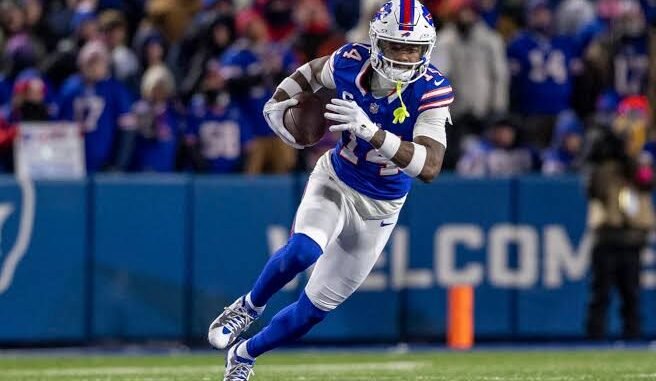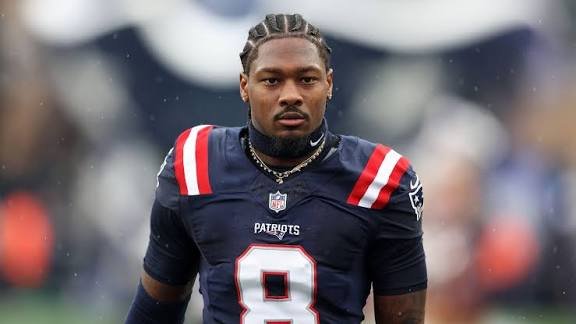
Introduction

Stefon Diggs remains one of the most compelling wide receivers in modern NFL discourse. His departure from Buffalo raised eyebrows among fans, analysts, and opponents alike. Questions persist: Why did Buffalo trade Stefon Diggs? And how has he performed lately—especially in his most recent outing?
In this article, we’ll dig deep into:
-
The context and reasons behind the Bills trading Diggs
-
The financial, team, and interpersonal factors influencing the decision
-
Diggs’s recent receiving yardage trends
-
A detailed look at his last game’s receiving stats
-
What this all means for Diggs, Buffalo, and his new team
Let’s begin.
Background: Diggs’s Tenure in Buffalo
To understand the trade, one must recall how Diggs arrived in Buffalo and how his time there evolved.
-
Trade origin: In 2020, the Bills acquired Stefon Diggs from the Minnesota Vikings. The trade was high-profile and seen as a coup for Buffalo.
-
On-field impact: Over his Buffalo tenure, Diggs compiled impressive numbers and became a key weapon alongside quarterback Josh Allen.
-
Peak seasons: He had standout seasons, including leading in receptions or receiving yards in certain years.
-
Shifting dynamics: As time passed, whispers of friction, diminished chemistry, and contract concerns grew louder.
By 2023–2024, the relationship between Diggs and Buffalo seemed strained. Reports of on-field inconsistency, public frustrations, and role-related disagreements began to surface.
Why Did Buffalo Trade Stefon Diggs?
Let’s break down the most significant factors that led the Bills to ultimately decide to move on from Diggs.
1. Contract and Salary Cap Pressures
One of the clearest drivers was the financial burden Diggs’s contract imposed.
-
The Bills would have faced a cap number of $27.854 million in 2024 had they retained him.
-
Trading Diggs did come with a substantial dead money hit—Buffalo reportedly would carry $31.096 million in dead cap that season.
-
In short, while Buffalo couldn’t fully avoid financial pain, the belief was that carrying dead money was preferable to tying up their long-term cap in a star no longer aligned with their future plans.
In GM Brandon Beane’s words, the timing made sense to execute the trade before the contract became even more burdensome.
2. Declining Role, Production & Age Considerations
While Diggs was still effective, there were signs that his role and productivity were not what they once were.
-
Analysts argued that Diggs had become a “diva on the decline” — his rapport with the team, particularly in critical moments, was under question.
-
In some late-season stretches, his consistency waned, and critique mounted that he faded in big games.
-
As a veteran receiver, age naturally becomes a consideration. The Bills may have judged that his peak years were behind him, particularly if they weren’t certain he’d remain engaged long-term.
3. Locker Room & Interpersonal Dynamics
Beyond numbers, relationships and team chemistry play a huge role in roster decisions.
-
There were reports of tension between Diggs and Josh Allen, especially after playoff disappointments. Some believed Diggs became dissatisfied with his target share or influence.
-
Diggs himself acknowledged struggles on and off the field during his final Buffalo season, which contributed to the split.
-
In professional sports, when a star player’s presence undermines broader cohesion or direction, organizations may decide the overall value lies in separating—even with substantial short-term cost.
4. Draft Capital & Rebuilding Strategy
Buffalo sought to pivot strategically.
-
The trade package: Buffalo sent Diggs (and some picks) to the Houston Texans in exchange for a 2025 second-round pick.
-
The idea: recoup high-value draft capital to reinvest in youth, accelerate roster flexibility, and reduce long-term financial risk.
-
The Bills likely judged that catching the tail end of Diggs’s prime was less valuable than reallocating resources toward future seasons.
Putting it simply, Buffalo decided that despite Diggs’s talent, the cost—financial, relational, and strategic—had become too steep.
The Trade: What Happened
Here’s a concise summary of the trade as it unfolded:
-
The Buffalo Bills traded Stefon Diggs to the Houston Texans.
-
Buffalo received a 2025 second-round pick in return.
-
Additional picks (a 2024 sixth-rounder and a 2025 fifth-rounder) were part of the compensation package.
-
Despite taking on the dead cap, Buffalo’s leadership believed the move opened breathing room for roster flexibility and a transition toward the future.
Diggs’s Recent Receiving Trends
To evaluate how Diggs has fared post-trade, it helps to look at his most recent receiving yardage metrics—and how his last game stacked up.
Season Stats (2025, with New England Patriots)
As of the current 2025 regular season:
-
19 receptions
-
213 receiving yards (ranked ~35th in the league)
-
0 touchdowns so far this season
-
Averaging 11.2 yards per reception
Those numbers suggest a modest output compared to elite receiver expectations—but they are contextually shaped by team offensive structure, target distribution, and matchups.
Recent Games & Yardage Patterns
-
Over the last 5 games, Diggs has accumulated 294 receiving yards, averaging roughly 58.8 yards per game.
-
In his last 10 games, he has totaled 639 receiving yards, averaging ~ 63.9 per game.
-
StatMuse reports that Diggs has had 56 catches for 574 yards over his last 10 games in another interpretation. (Some discrepancy across data sources.)
These trends show that while Diggs is no longer posting eye-popping numbers week in, week out, he is still a steady contributor.
Last Game (vs Buffalo, 2025)
In his most recent outing — a return to Buffalo with the New England Patriots — Diggs turned in a notable performance:
-
10 receptions,
-
146 receiving yards
-
This strong showing came in a narrow 23–20 loss, and further underscored the emotional weight of facing his former team.
This performance is particularly significant, as it marks one of his highest yardage games in recent memory, especially in a high-pressure match against his old organization.
Interpreting the Move: Why It Makes Sense (and Where It’s Risky)
Let’s step back and reflect: was Buffalo right? What are the upside and downside?
Pros of the Trade (for Buffalo)
-
Financial flexibility
Handling dead money now rather than trapping future cap with an onerous contract gives Buffalo room to invest elsewhere. -
Youth investment
Turning Diggs into a high-value second-rounder frees space for rookie contracts, positional depth, or trade flexibility. -
Reduced interpersonal friction
If locker room conflicts or mismatched expectations were real, moving on can restore cohesion. -
Forward-looking roster building
Bills could pivot toward balancing their roster, shifting emphasis to defense, or grooming the next generation of receivers.
Risks & Challenges
-
Loss of elite-level talent
Even aging, Diggs still offers playmaking ability—Buffalo must replace that input. -
Dead money burden
The $31 million hit is steep. If the new spending doesn’t pan out, the penalty could loom large. -
Uncertainty in replacement
Young receivers can be volatile. Buffalo betting on less certain performers invites risk. -
Fan and morale backlash
Trading beloved stars often brings criticism, especially if short-term results lag.
On balance, the move signals Buffalo’s belief that the long-term gains outweigh the short-term pain.
FAQ (Frequently Asked Questions)
Q1: Why did the Buffalo Bills choose to trade Stefon Diggs instead of negotiating a new contract?
Negotiating a new deal would have likely kept Diggs’s high cap burden alive, limiting Buffalo’s flexibility. With declining alignment, trading allowed the Bills to recoup draft capital and reallocate resources rather than remain locked into his expensive contract.
Q2: Didn’t Buffalo take a big dead cap hit by trading Diggs?
Yes — the Bills absorbed around $31.096 million in dead money for the 2024 season. This is a rare and bold decision for a receiver. However, leadership deemed it preferable to having that cap tied up in a star no longer aligned with their direction.
Q3: How did Diggs perform in his most recent game?
In his return to Buffalo as a member of the New England Patriots, Diggs caught 10 passes for 146 receiving yards in a narrow 23–20 loss.
Q4: What are Diggs’s averages over his last 10 games?
He’s recorded approximately 639 receiving yards in his 10 most recent outings, averaging about 63.9 yards per game. Some sources list slight variations (e.g. 574 yards), reflecting data differences.
Q5: Has the trade been universally praised as a win for Buffalo?
Not universally. Opinions remain mixed. Supporters cite financial prudence, roster realignment, and moving on from internal friction. Critics argue Buffalo gave up too much talent and failed to secure immediate replacements. The true judgment likely won’t come until seasons ahead.
Q6: What now for Diggs with New England (or his current team)?
Diggs continues to showcase he can still produce—he remains a veteran presence and a potential difference-maker in key matchups. His strong recent performance vs. Buffalo is a reminder that he still possesses playmaking capability in the right circumstances.
Conclusion
The saga of Stefon Diggs: Why Did Buffalo Trade | Receiving Yards Last Game reveals a complex tapestry of financial calculus, player-team chemistry, and performance management. Buffalo’s decision to move on was bold, costly, and strategic. They traded exceptional talent in Diggs—not because they undervalued him, but because they judged that the long-term cost was unsustainable.
Meanwhile, Diggs’s recent yards, including the 146 in his return to Buffalo, affirm he still has game left in him—even as his role evolves. Only time will reveal which side truly came out ahead.

Leave a Reply